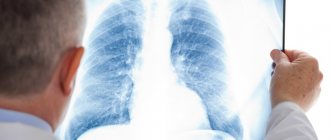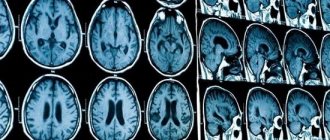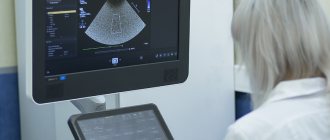Lobar pneumonia is an acute infectious disease in which one or more lobes of the lung are affected, fibrinous effusion appears in the alveoli, and fibrinous deposits appear on the pleura. Croupous pneumonia affects mainly adults. The disease is characterized by a pronounced clinical picture and symptoms of intoxication. Patients with lobar pneumonia are admitted to the therapy clinic.
To examine patients at the Yusupov Hospital, doctors use modern equipment from leading European, American and Japanese companies. Pulmonologists use European treatment protocols and take an individual approach to the choice of treatment method for each patient. Medicines are administered through the digestive tract, intramuscularly, intravenously and by inhalation. Thanks to complex treatment, the length of stay of patients in hospital is reduced.
Signs of lobar pneumonia in adults
With lobar pneumonia, symptoms appear acutely. Key ones:
- a sharp increase in temperature to 39 - 40 ° C;
- severe chills, weakness;
- chest pain when breathing;
- cough - at first dry, but quickly becomes wet, with rust-colored sputum;
- severe shortness of breath;
- wheezing that may be heard when breathing;
- rapid heartbeat, low blood pressure;
- pale skin, nausea, muscle weakness.
The general condition is serious, the patient needs the help of doctors in the hospital.
Symptoms of lobar pneumonia
Lobar pneumonia has an acute onset. In patients in full health, body temperature rises to 39 ° C, chills and chest pain appear. In the initial stage of the disease, the cough is dry, then it becomes productive, with the release of “rusty” sputum. There is severe shortness of breath, the chest on the affected side lags behind when breathing.
In the initial phase of inflammation, percussion reveals a dull tympanic sound over the lesion. During auscultation, harsh breathing with prolonged exhalation, mild crepitus, and wet and dry rales in a limited area are heard. In the compaction phase of lobar pneumonia, the following symptoms appear:
- a sharp increase in vocal tremors, bronchophony during palpation of the chest;
- with percussion – dull sound;
- vesicular breathing is not audible, crepitus disappears, and pleural friction noise is often heard.
In the resolution phase, vocal tremors gradually normalize, bronchophony disappears, and abundant, sonorous crepitus appears over a long period of time. Loud fine-bubble rales are heard, bronchial breathing gradually gives way to harsh and then vesicular breathing.
When examining the cardiovascular system, a rapid pulse is determined. In the case of severe lobar pneumonia, it is poorly filled, arrhythmic, blood pressure is reduced, and the heart sounds are muffled.
Stages of lobar pneumonia in adults
Lobar pneumonia proceeds according to a special scenario, with a change of stages with typical changes in the lung tissue.
Stage one - high tide. A lot of blood flows to the lung tissue, which is why it turns red, and blood stagnates in small vessels. The stage lasts from 12 - 14 hours to 3 days.
Stage two – red liver. During this period, some of the fluid and red blood cells leak out of the small vessels of the lungs into the alveoli, which is why they work poorly. The affected part of the lung becomes dense, similar in appearance to liver tissue. Fibrin accumulates inside the lung sacs, a sticky substance that gives the tissue its density. This stage lasts up to 3 days.
Stage three – gray hepatization. Red blood cells stop entering the lung tissue, they are replaced by leukocytes and fibrin, epithelium. Therefore, the color of the lungs changes to gray and greenish. The stage lasts from 2 to 6 days.
Stage four – resolution. Gradually, fibrin dissolves, the alveoli are cleared, the lungs are restored and begin to breathe normally. This process is the longest, can last up to 2 - 3 weeks.
How does infection occur?
The causative agents of lobar pneumonia are pneumococci types I-IV. Less commonly, the disease is caused by Friendler's diplobacillus. As a rule, inflammation manifests itself acutely, against the background of absolute health and lack of contact with infected persons. Based on this, we can conclude that the infectious agents were previously in the upper respiratory tract, but their reproduction was restrained due to the work of the immune system. Its weakening is one of the leading factors in the development of lobar pneumonia.
From the point of view of modern medicine, lobar pneumonia is considered an infectious-allergic disease. In the vast majority of cases, the disease develops as a result of infection of the lungs with type I and II pneumococci. The polysaccharide capsule of pneumococci ensures their virulence and also provokes pronounced sensitization of the body.
Conditions that are necessary for the development of lobar pneumonia:
- Primary penetration of pneumococci into the body and development of inflammation. Moreover, its focus may not be located in the lung tissue, but may have a different localization.
- Sensitization of the body to a certain type of pneumococcus and re-entry of infection.
So, lobar pneumonia develops under the condition of secondary infection with pneumococci. An important condition is the fact of re-infection at the peak of sensitization of the body to microbes of a certain type. They can enter the lungs through blood, lymph or airborne droplets.
If all conditions are met, a violent reaction develops in the body, which is similar to what occurs when a foreign protein is introduced. A whole chain of morphological changes is launched in the lungs, which were described by Laennec (flush, red and gray hepatitis, resolution). Inflammatory exudate accumulates in the alveoli, a significant proportion of which is fibrin.
Modern methods of treatment
To treat lobar pneumonia, your doctor will prescribe two antibiotics.
One drug is administered intravenously, the second intramuscularly. Usually these are drugs from the group of penicillins and cephalosporins. Stronger medications are required less often. Additionally, complex therapy is required:
- immunocorrection (blood plasma and immunoglobulins are administered);
- correction of blood clotting disorders (intravenous blood thinning solutions, heparin);
- normalization of the protein composition of the blood (intravenous albumin, retabolil);
- oxygen (supplied through a nasal catheter or mask);
- hormonal drugs (for severe cases, prednisone is used for a short course);
- antioxidant therapy (ascorbic acid, rutin);
- bronchodilators (Berodual, Eufillin, Atrovent);
- expectorants (ACC, Bromhexine, Ambrobene, Lazolvan);
- antipyretic drugs (Nurofen, Paracetamol, Ibuklin);
- physiotherapy, massage, exercise therapy.
As the patient’s condition improves, he undergoes a course of rehabilitation to completely eliminate foci of inflammation in the lungs.
Features of the course of the disease in children
Children rarely experience fever and chills, and they do not complain of pain in the side.
An atypical course of lobar pneumonia is observed in young children. At the onset of the disease, there is no cough, but other symptoms occur: dry mouth, bloating, nausea and vomiting, abdominal pain, pale skin, rapid breathing, hyperexcitation or lethargy, enlarged liver. Sometimes there is a stiff neck, headache, convulsions, delirium and hallucinations. The combination of such symptoms can cause an incorrect diagnosis (meningitis). As pneumonia progresses, meningeal signs give way to the classic clinical picture of pneumonia.
Croupous pneumonia rarely develops in children. People aged 18-40 years are most susceptible to it.
In children 7-16 years old, symptoms do not differ from those that occur in adults. Body temperature stabilizes on days 5-9 from the onset of the disease. At the same time, inflammation in the lungs subsides.
Popular questions and answers
Pulmonologist Marina Samoilova told us why lobar pneumonia is so dangerous and how to treat it.
What complications can occur with lobar pneumonia?
If a person has a weakened immune system or treatment is started untimely or incorrectly, complications are possible in the form of:
- abscess (purulent melting of lung tissue); gangrene of the lung;
- purulent pericarditis (inflammation of the lining of the heart);
- purulent brain damage;
- blood poisoning;
- respiratory failure and even death.
Pneumococcal pneumonia, even in our time, is a fairly common cause of death, especially in older people, smokers, people suffering from alcoholism, with cancer and systemic diseases, and HIV-infected people.
Story
Pneumonia was first described by Hippocrates around 460 BC, but until the 19th century it was not known that it was an infection of the lungs and not a symptom of other diseases. The first clinical and pathological manifestations were described by the French physician René Laennec in 1819, and in 1842 the Austrian pathologist Karl Rokitansky was the first to differentiate pneumonia into lobar and bronchopneumonia. The infectious nature was discovered in 1875 by the German pathologist Edwin Klebs, who observed bacteria under a microscope, and in 1884 Karl Friedlander and Frenkel, Albert were able to identify the two most common pathogens of pneumonia at that time - Streptococcus pneumoniae (pneumococcus) and Klebsiella pneumonia. By 1929, the International List of Causes of Death had 94 terms for pneumonia; later in the ICD-10 classifier, many of the descriptive terms that included pneumonia were eventually removed, but it is still listed in descriptive terms for some infectious and noninfectious causes, including complications from certain diseases and procedures. In the 1930s, penicillin developed treatments for bacterial pneumonia, but pneumonia is still the leading cause of death among children under 5 years of age.
23.01.2021 7219
Is it possible to treat lobar pneumonia with folk remedies?
As a rule, patients with lobar pneumonia should be hospitalized for constant monitoring by medical staff and emergency measures at the slightest sign of complications.
Often such patients experience nausea, vomiting, bowel movements, and confusion, so medications and solutions are administered intravenously. Thus, we cannot talk about treatment at home without the participation of qualified specialists. Fortunately, in our time, subject to a healthy lifestyle, such serious diseases as lobar pneumonia are becoming less and less common, and with modern treatment methods, in most cases it is possible to avoid serious complications and save the patient’s life.
Published on the portal kp.ru
Prevention
Prevention of pneumonia is an important factor in reducing child mortality. Vaccination against Haemophilus influenzae type B, pneumococcus, measles and whooping cough is the most effective way to prevent pneumonia. For young children, nutrition plays an important role, particularly exclusive breastfeeding for the first 6 months of life. Reduces the incidence of illness among children and combats air pollution, for example, through the use of environmentally friendly cookstoves in residential buildings. In overcrowded homes, providing hygienic conditions can help reduce disease incidence.
In health care settings, effective measures to reduce the spread of infection include hand washing and the use of gloves and masks, and patient isolation is recommended.
Vaccinal prevention
Vaccinal prevention of pneumococcal infections
According to the position of WHO and the Russian Respiratory Society, “Vaccination is the only way to prevent the development of pneumococcal infection.” In the Russian Federation, 94% of all etiologically deciphered cases of complicated pneumococcal infection in children are caused by pneumococcal community-acquired pneumonia. Pneumococcus is the cause of up to 76% of community-acquired pneumonia in Russian adults. For vaccination against pneumococcal infection of persons over 2 years of age in the USA since 1983, and in the Russian Federation since 1999, polysaccharide polyvalent vaccines containing antigens of 23 serotypes, causing up to 90% of invasive diseases of pneumococcal etiology, have been successfully used. Vaccination is carried out once, followed by revaccination for patients from high-risk groups (over 65 and immunocompromised individuals) after 5 years. The effectiveness of polysaccharide vaccines reaches 80%, but may be lower in elderly people, patients with immunodeficiency conditions, and in children under 2 years of age. These vaccines cause the formation of T-independent B-cell immunity.
Is pneumonia contagious?
The inflammatory process in the pulmonary system most often appears due to the multiplication of the virus and as a complication of influenza or acute respiratory viral infection. In such cases, it is impossible to get sick from pneumonia itself, but it is easy to catch the disease that became the root cause. That is, pneumonia itself is not contagious, and the development of inflammation in the lungs is an independent complication that arose against the background of a weakened immune system and improper self-medication.
Can pneumonia go away on its own without treatment?
Pneumonia or pneumonia is one of the most dangerous and common diseases of the respiratory system. The danger is that specialists do not always have time to make a diagnosis in time. People do not go to the doctor with a cough and fever, but prefer to stay at home for a couple of days until the disease spreads. The condition can worsen to bilateral pneumonia, which carries severe consequences, long-term treatment or chronic diseases.
A hundred years ago, before the discovery of penicillin, pneumonia took the lives of those who fell ill. Science and medicine do not stand still - our lives have changed dramatically in a hundred years. People have antibiotics in every medicine cabinet, and hospitals carry out operations using modern equipment. However, according to the Russian Academy of Sciences, pneumonia is still on the list of the deadliest infectious diseases and should not be underestimated.
Pneumonia will not go away on its own. This disease can lead to death, so seeing a doctor is vital. Treatment for pneumonia should be prescribed by a doctor. It is he who determines whether antibiotics are needed and which ones, and also decides on the severity of the disease.
With pneumonia there is always a high temperature and a strong cough, is this true?
This is a very big and dangerous misconception. Errors in diagnosing the disease are one of the main causes of mortality from pneumonia. According to doctors, up to 30% of cases of pneumonia are not diagnosed or detected too late, since people do not see the need to see a doctor before a high temperature appears. As a result, this leads to a deterioration in the person’s condition and the development of severe complications. Asymptomatic, hidden, but real pneumonia often develops in children and the elderly. The main and most dangerous problem in diagnosing pneumonia in elderly patients is that the disease successfully disguises itself as various chronic diseases. In this case, it passes without the most important marker of the disease for us - without fever. How then do you understand that pneumonia is going away in an adult? - Monitor your body, and promptly consult a doctor if your health worsens.
If you have what signs you should consult a doctor?
- increased sweating;
- weakness;
- dyspnea.
By the way, the myth that pneumonia is necessarily accompanied by a severe cough is just a myth. This problem is mostly characteristic not of the older generation, but of children. There are often cases when pneumonia progresses, but there is no cough. If you do not consult a doctor in time and do not make a diagnosis, the child may experience chronic consequences.
Pneumonia in children can be identified by the following symptoms:
- shortness of breath and chest pain when moving;
- pain when turning the body
- inability to take a deep breath;
- tachycardia;
- exercise intolerance;
- fast fatiguability;
- weakness;
- the person looks pale, but with a bright, unhealthy blush.
How is pneumonia transmitted?
The disease can be transmitted in different ways, including:
- Airborne method. During the disease, droplets form on the mucous membrane of the mouth and nose, which spread through the air during sneezing and coughing. You can become infected by airborne droplets in any public place: hospital, store, public transport. The pathogenic agent spreads through the air along with particles of mucus, sputum, and saliva.
- Contact. The infection is also transmitted through contact - shaking hands, hugging, kissing. People become infected when they touch contaminated objects or when they touch their mouth, eyes, or nose with dirty hands.
- Domestic. The infection can be transmitted through shared towels, dishes and bedding. Therefore, the patient needs to be provided with personal hygiene items, and, if possible, change and wash them more often.
- Fecal. The virus survives up to two days in fecal matter with normal bowel movements. You can easily acquire the disease from improper toilet cleaning or personal hygiene. To prevent infection, especially from young children, it is important to constantly wash your hands after cleaning the child's potty, change diapers frequently and thoroughly wash the area where bowel movements occur.
However, personal hygiene items must be handled very carefully. It has been proven that the viral microorganism can survive up to 4 hours on any surface. Morbid bacteria are not afraid of frost; even with bleach it can be destroyed only five minutes after direct treatment.
Sputum due to pneumonia is dark in color
The appearance of rust-colored sputum can be observed in smokers. This suggests that you need to get rid of the bad habit urgently. Also, dark color of sputum can be observed when consuming certain foods and drinks, for example, chocolate, coffee, red wine.
If dark-colored sputum is present for a long time, this may be a sign of:
- chronic pneumonia;
- chronic bronchitis;
- tuberculosis;
- lung cancer;
- pneumoconiosis.
In any case, the patient should consult a doctor.
White or gray sputum
Transparent sputum, discharge of white and gray shades are absolutely normal. But their excessive quantity may indicate various pathologies, namely:
- allergies;
- chronic bronchitis;
- respiratory tract infections;
- pulmonary edema.
Gray sputum may be the result of smoking or severe air pollution.
Diagnostics at the Yusupov Hospital will either refute the suspicion of pathology, and the patient will know for sure that nothing threatens his health, or will allow a timely course of effective treatment to be prescribed and prevent the development of severe complications.
To make an appointment with a doctor at the Yusupov Hospital, you do not need to stand in queues, adjust your work schedule, the hospital administrators will coordinate a visit to the doctor at a time convenient for each patient.
Sputum from pneumonia mixed with blood
The presence of a pinkish tint of mucus, streaks and blood stains in it may indicate various diseases, the most dangerous of which is lung cancer.
But sputum mixed with blood can also appear when:
- pneumococcal pneumonia
- internal bleeding;
- tuberculosis;
- pulmonary edema due to chronic heart failure;
- lung abscess.
The appearance of sputum with blood is always a sign of a serious illness and requires urgent medical intervention. The Yusupov Hospital accepts patients 7 days a week, 24 hours a day. You can make an appointment with a doctor in advance by calling the clinic’s phone number.
Pneumonia among all pulmonary pathologies in young children is almost 80%. Even with the introduction of progressive technologies in medicine - the discovery of antibiotics, improved diagnostic and treatment methods - this disease is still one of the ten most common causes of death. According to statistical data in various regions of our country, the incidence of pneumonia in children is 0.4-1.7%.
- Improper treatment of influenza and ARVI can lead to pneumonia in a child
- Pneumonia in children - differential diagnosis of ARVI, acute bronchitis and bronchiolitis
- Signs of pneumonia in a child. Symptoms of pneumonia in infants, children under one year old
- Chlamydial, mycoplasma pneumonia in a child
- Indications for hospitalization
- Treatment of pneumonia in a child
When and why can pneumonia occur in a child?
The lungs perform several important functions in the human body. The main function of the lungs is gas exchange between the alveoli and the capillaries that envelop them.
Simply put, oxygen from the air in the alveoli is transported into the blood, and carbon dioxide from the blood enters the alveoli.
They also regulate body temperature, regulate blood clotting, are one of the filters in the body, promote cleansing, the removal of toxins, breakdown products that occur during various injuries, and infectious inflammatory processes. And in the event of food poisoning, burns, fractures, surgical interventions, or any serious injury or illness, a general decrease in immunity occurs, and it is more difficult for the lungs to cope with the load of filtering toxins.
That is why very often a child develops pneumonia after suffering or against the background of injuries or poisoning.
Most often, the causative agent of the disease is pathogenic bacteria - pneumococci, streptococci and staphylococci, and recently cases of the development of pneumonia from pathogens such as pathogenic fungi, legionella (usually after staying in airports with artificial ventilation), mycoplasma, chlamydia, which are not They are rarely mixed or associated.
Pneumonia in a child, as an independent disease that occurs after serious, severe, prolonged hypothermia, is extremely rare, since parents try to prevent such situations.
As a rule, in most children, pneumonia does not occur as a primary disease, but as a complication after ARVI or influenza, less often than other diseases.
Why is this happening?
Many of us believe that acute viral respiratory diseases have become more aggressive and dangerous due to their complications in recent decades. This may be due to the fact that both viruses and infections have become more resistant to antibiotics and antiviral drugs, which is why they are so severe in children and cause complications.
One of the factors in the increase in the incidence of pneumonia in children in recent years has been the general poor health of the younger generation - how many children today are born with congenital pathologies, developmental defects, and lesions of the central nervous system.
A particularly severe course of pneumonia occurs in premature or newborn babies, when the disease develops against the background of an intrauterine infection with an insufficiently formed, immature respiratory system.
In congenital pneumonia, the causative agents are often herpes simplex virus, cytomegalovirus, mycoplasma, and when infected during childbirth - chlamydia, group B streptococci, opportunistic fungi, Escherichia coli, Klebsiella, anaerobic flora; when infected with hospital infections, pneumonia begins on the 6th day or 2 weeks after birth.
Naturally, pneumonia most often occurs in cold times, when the body already undergoes a seasonal adjustment from heat to cold and vice versa, overloads occur for the immune system, at this time there is a lack of natural vitamins in foods, temperature changes, damp, frosty, windy weather contribute to hypothermia of children and their infection.
In addition, if a child suffers from any chronic diseases - tonsillitis, adenoids in children, sinusitis, dystrophy, rickets (see rickets in an infant), cardiovascular disease, any severe chronic pathologies, such as congenital lesions of the central nervous system, developmental defects, immunodeficiency states - significantly increase the risk of developing pneumonia and aggravate its course.
The severity of the disease depends on:
- Extensiveness of the process (focal, focal-confluent, segmental, lobar, interstitial pneumonia).
- The age of the child, the younger the baby, the narrower and thinner the airways, the less intense gas exchange in the child’s body and the more severe the course of pneumonia.
- Places where and for what reason pneumonia occurred:
— community-acquired: most often have a milder course
— hospital: more severe, since infection with bacteria resistant to antibiotics is possible
- aspiration: when foreign objects, mixture or milk enter the respiratory tract.
The most important role is played by the general health of the child, that is, his immunity.
Improper treatment of influenza and ARVI can lead to pneumonia in a child
When a child gets sick with a common cold, acute respiratory viral infection, or influenza, the inflammatory process is localized only in the nasopharynx, trachea and larynx.
If the immune response is weak, and also if the pathogen is very active and aggressive, and the child is treated incorrectly, the process of bacterial reproduction descends from the upper respiratory tract to the bronchi, then bronchitis may occur. Further, inflammation can also affect lung tissue, causing pneumonia.
What happens in a child’s body during a viral disease?
In most adults and children, various opportunistic microorganisms - streptococci, staphylococci - are always present in the nasopharynx, without causing harm to health, since local immunity inhibits their growth.
However, any acute respiratory disease leads to their active reproduction, and if the parents act correctly during the child’s illness, the immune system does not allow their intensive growth.
What should not be done during ARVI in a child to avoid complications:
Antitussives should not be used.
Coughing is a natural reflex that helps the body clear the trachea, bronchi and lungs of mucus, bacteria, and toxins. If, to treat a child, in order to reduce the intensity of a dry cough, you use antitussives that affect the cough center in the brain, such as Stoptusin, Bronholitin, Libexin, Paxeladin, then an accumulation of sputum and bacteria in the lower respiratory tract may occur, which ultimately leads to pneumonia.
You cannot carry out any preventive antibiotic therapy for colds or viral infections.
Antibiotics are powerless against the virus, but the immune system must cope with opportunistic bacteria, and their use is indicated only if complications arise as prescribed by a doctor.
The same applies to the use of various nasal vasoconstrictors; their use promotes faster penetration of the virus into the lower respiratory tract, therefore Galazolin, Naphthyzin, Sanorin are not safe to use for a viral infection.
Drinking plenty of fluids - one of the most effective methods of relieving intoxication, thinning mucus and quickly clearing the airways is drinking plenty of fluids, even if the child refuses to drink, parents should be very persistent.
If you do not insist that the child drinks a sufficiently large amount of liquid, there will also be dry air in the room - this will help dry out the mucous membrane, which can lead to a longer course of the disease or a complication - bronchitis or pneumonia.
Constant ventilation, the absence of carpets and rugs, daily wet cleaning of the room in which the child is located, humidification and purification of the air using a humidifier and air purifier will help to quickly cope with the virus and prevent pneumonia from developing. Because clean, cool, moist air helps to thin sputum, quickly eliminate toxins through sweat, cough, and wet breath, which allows the child to recover faster.
Acute bronchitis and bronchiolitis - differences from pneumonia
ARVI usually has the following symptoms:
- High temperature in the first 2-3 days of illness (see antipyretics for children)
- Headache, chills, intoxication, weakness
- Qatar of the upper respiratory tract, runny nose, cough, sneezing, sore throat (not always the case).
In case of acute bronchitis against the background of acute respiratory viral infection, the following symptoms may occur:
- Slight increase in body temperature, usually up to 38C.
- At first the cough is dry, then it becomes wet, there is no shortness of breath, unlike pneumonia.
- Breathing becomes harsh, various scattered wheezes appear on both sides, which change or disappear after coughing.
- The radiograph shows an increase in the pulmonary pattern, and the structure of the roots of the lungs decreases.
- There are no local changes in the lungs.
Bronchiolitis occurs most often in children under one year of age:
- The difference between bronchiolitis and pneumonia can only be determined by X-ray examination, based on the absence of local changes in the lungs. According to the clinical picture, acute symptoms of intoxication and an increase in respiratory failure, the appearance of shortness of breath - are very similar to pneumonia.
- With bronchiolitis, the child’s breathing is weakened, shortness of breath with the participation of auxiliary muscles, the nasolabial triangle becomes bluish, general cyanosis and severe pulmonary heart failure are possible. When listening, a boxy sound and a mass of scattered fine-bubble rales are detected.
Signs of pneumonia in a child
When the infectious agent is highly active, or when the body’s immune response to it is weak, when even the most effective preventive treatment measures do not stop the inflammatory process and the child’s condition worsens, parents can guess from some symptoms that the child needs more serious treatment and urgent medical examination.
At the same time, under no circumstances should you start treatment with any traditional method. If it really is pneumonia, not only will this not help, but the condition may worsen and time will be lost for adequate examination and treatment.
Symptoms of pneumonia in a child 2 - 3 years old and older
How can attentive parents determine if they have a cold or viral illness that they should urgently call a doctor and suspect pneumonia in their child?
Symptoms that require x-ray diagnostics:
- After an acute respiratory infection or flu, there is no improvement in the condition for 3-5 days, or after a slight improvement, a jump in temperature and increased intoxication and cough reappear.
- Lack of appetite, lethargy of the child, sleep disturbances, and moodiness persist for a week after the onset of the illness.
- The main symptom of the disease remains a severe cough.
- The body temperature is not high, but the child has shortness of breath. At the same time, the number of breaths per minute in a child increases, the norm of breaths per minute in children aged 1-3 years is 25-30 breaths, in children 4-6 years old - the norm is 25 breaths per minute, if the child is in a relaxed, calm state. With pneumonia, the number of breaths becomes greater than these numbers.
- With other symptoms of a viral infection - cough, fever, runny nose - pronounced pallor of the skin is observed.
- If the temperature is high for more than 4 days and antipyretics such as Paracetamol, Efferalgan, Panadol, Tylenol are not effective.
Symptoms of pneumonia in infants, children under one year old
The mother can notice the onset of the disease by changes in the baby’s behavior. If a child constantly wants to sleep, becomes lethargic, apathetic, or vice versa, is capricious a lot, cries, refuses to eat, and the temperature may rise slightly, the mother should immediately consult a pediatrician.
Body temperature
In the first year of life, pneumonia in a child, the symptom of which is considered to be a high, unbroken temperature, is distinguished by the fact that at this age it is not high, does not reach 37.5 or even 37.1-37.3.
However, temperature is not an indicator of the severity of the condition.
The first symptoms of pneumonia in an infant
This is causeless anxiety, lethargy, loss of appetite, the baby refuses to breastfeed, sleep becomes restless, short, loose stools appear, there may be vomiting or regurgitation, runny nose and paroxysmal cough, which intensifies while the baby is crying or feeding.
Baby's breathing
Chest pain when breathing and coughing.
Sputum - with a wet cough, purulent or mucopurulent sputum (yellow or green) is released.
Shortness of breath or an increase in the number of breathing movements in young children is a clear sign of pneumonia in a child. Shortness of breath in infants may be accompanied by nodding of the head in time with breathing, and the baby also puffs out his cheeks and stretches out his lips, sometimes foamy discharge appears from the mouth and nose.
A symptom of pneumonia is considered to be exceeding the normal number of breaths per minute:
- In children under 2 months, the norm is up to 50 breaths per minute; over 60 is considered a high frequency.
- In children from 2 months to a year, the norm is 25-40 breaths, if 50 or more, then this is exceeding the norm.
- In children older than one year, the number of breaths exceeding 40 is considered shortness of breath.
Skin texture changes when breathing
Attentive parents may also notice retraction of the skin when breathing, usually on one side of the diseased lung.
To notice this, you should undress the baby and observe the skin between the ribs; it retracts when breathing. With extensive lesions, one side of the lung may lag behind during deep breathing.
Sometimes you can notice periodic stops in breathing, disturbances in the rhythm, depth, frequency of breathing, and the child’s desire to lie on one side.
Cyanosis of the nasolabial triangle
This is the most important symptom of pneumonia, when blue skin appears between the baby’s lips and nose. This sign is especially pronounced when the baby is breastfeeding.
With severe respiratory failure, slight blue discoloration may appear not only on the face, but also on the body.
Chlamydial, mycoplasma pneumonia in a child
Among pneumonias, the causative agents of which are not common bacteria, but various atypical representatives, mycoplasma and chlamydial pneumonia are distinguished.
In children, the symptoms of such pneumonia are somewhat different from the course of ordinary pneumonia. Sometimes they are characterized by a hidden, sluggish course.
Signs of atypical pneumonia in a child may be as follows:
- The onset of the disease is characterized by a sharp rise in body temperature to 39.5 C, then a persistent low-grade fever forms -37.2-37.5 or even normalization of temperature occurs.
- It is also possible that the disease begins with the usual signs of ARVI - sneezing, sore throat, severe runny nose.
- Persistent dry debilitating cough, shortness of breath may not be constant. This cough usually occurs with acute bronchitis, not pneumonia, which complicates the diagnosis.
- When listening, the doctor is most often presented with scant data: rare wheezing of various sizes, pulmonary percussion sound. Therefore, it is difficult for a doctor to determine atypical pneumonia based on the nature of wheezing, since there are no traditional signs, which greatly complicates the diagnosis.
- There may be no significant changes in the blood test for SARS. But usually there is an increased ESR, neutrophilic leukocytosis, combination with anemia, leukopenia, eosinophilia.
- A chest x-ray reveals a pronounced increase in the pulmonary pattern and heterogeneous focal infiltration of the pulmonary fields.
- Both chlamydia and mycoplasma have the ability to exist for a long time in the epithelial cells of the bronchi and lungs, so most often pneumonia is of a protracted, recurrent nature.
- Treatment of atypical pneumonia in a child is carried out with macrolides (azithromycin, josamycin, clarithromycin), since the pathogens are most sensitive to them (to tetracyclines and fluoroquinolones, too, but they are contraindicated for children).
Indications for hospitalization
The decision about where to treat a child with pneumonia - in a hospital or at home - is made by the doctor, and he takes into account several factors:
The severity of the condition and the presence of complications - respiratory failure, pleurisy, acute disturbances of consciousness, heart failure, drop in blood pressure, lung abscess, pleural empyema, infectious-toxic shock, sepsis.
Damage to several lobes of the lung. Treatment of focal pneumonia in a child at home is quite possible, but for lobar pneumonia it is better to treat it in a hospital setting.
Social indications are poor living conditions, inability to carry out care and doctor’s orders.
Age of the child - if an infant falls ill, this is grounds for hospitalization, since pneumonia in an infant poses a serious threat to life. If pneumonia develops in a child under 3 years of age, treatment depends on the severity of the condition and most often doctors insist on hospitalization. Older children can be treated at home, provided that the pneumonia is not severe.
General health - in the presence of chronic diseases, weakened general health of the child, regardless of age, the doctor may insist on hospitalization.
Treatment of pneumonia in a child
Antibiotics are the mainstay of treatment for pneumonia. At a time when doctors did not have antibiotics in their arsenal for bronchitis and pneumonia, pneumonia was a very common cause of death in adults and children, so in no case should you refuse to use them; no folk remedies are effective for pneumonia.
Parents are required to strictly follow all the doctor’s recommendations, provide proper care for the child, adhere to the drinking regime, nutrition:
Taking antibiotics must be carried out strictly on time; if the drug is prescribed 2 times a day, this means that there should be a break of 12 hours between doses, if 3 times a day, then a break of 8 hours. Antibiotics are prescribed - penicillins, cephalosporins for 7 days, macrolides (azithromycin, josamycin, clarithromycin) - 5 days. The effectiveness of the drug is assessed within 72 hours - improvement in appetite, decrease in temperature, shortness of breath.
Antipyretics are used if the temperature is above 39C , in infants above 38C. At first, antipyretic antibiotics are not prescribed, since it is difficult to assess the effectiveness of therapy. It should be remembered that during high temperatures the body produces the maximum amount of antibodies against the pathogen, so if a child can tolerate a temperature of 38C, it is better not to knock it down. This way the body can quickly cope with the microbe that caused pneumonia in the baby. If a child has had at least one episode of febrile convulsions, the temperature should be brought down already at 37.5C.
Feeding a child with pneumonia - lack of appetite in children during illness is considered natural and the child’s refusal to eat is explained by the increased load on the liver when fighting the infection, so you cannot force feed the child. If possible, you should prepare light food for the patient, exclude any ready-made chemicalized foods, fried and fatty, try to feed the child simple, easily digestible food - porridge, soups with a weak broth, steamed cutlets from lean meat, boiled potatoes, various vegetables, fruits.
Oral hydration - in water, natural freshly squeezed diluted juices - carrot, apple, weakly brewed tea with raspberries, rosehip infusion, water-electrolyte solutions are added (Rehydron, etc.).
Ventilation, daily wet cleaning, and the use of air humidifiers alleviate the baby’s condition, and the love and care of parents works wonders.
No general tonic (synthetic vitamins), antihistamines, or immunomodulators are used, since they often lead to side effects and do not improve the course and outcome of pneumonia.
Taking antibiotics for pneumonia in a child (uncomplicated) usually does not exceed 7 days (macrolides 5 days), and if you follow bed rest, follow all the doctor’s recommendations, in the absence of complications, the child will quickly recover, but within a month there will still be residual effects in the form cough, slight weakness.
With atypical pneumonia, treatment may take longer. P
When treated with antibiotics, the intestinal microflora in the body is disrupted, so the doctor prescribes probiotics - RioFlora Immuno, Acipol, Bifiform, Bifidumbacterin, Normobact, Lactobacterin.
To remove toxins after completion of therapy, the doctor may prescribe sorbents such as Polysorb, Enterosgel, Filtrum.
If the treatment is effective, the child can be transferred to a general regimen and walks from the 6-10th day of illness, and hardening can be resumed after 2-3 weeks.
In case of mild pneumonia, heavy physical activity (sports) is allowed after 6 weeks, in case of complicated pneumonia after 12 weeks.
Source: https://zdravotvet.ru/










